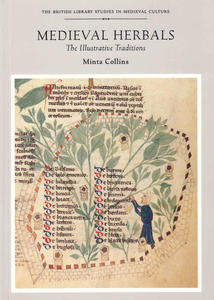Medieval Herbals. The Illustrative Traditions
CODICE: ISBN 0802083137 EAN 9780802083135
AUTORE/CURATORE/ARTISTA :
Author: Minta Collins
EDITORE/PRODUTTORE : University of Toronto Press
COLLANA/SERIE : British Library Studies in Medieval Culture
DISPONIBILITA': Disponibile
TITOLO/DENOMINAZIONE:
Medieval Herbals. The Illustrative Traditions
PREZZO : EUR 44,95€
CODICE :
ISBN 0802083137
EAN 9780802083135
AUTORE/CURATORE/ARTISTA :
Author: Minta Collins
EDITORE/PRODUTTORE:
University of Toronto Press
COLLANA/SERIE:
British Library Studies in Medieval Culture
ANNO:
2000
DISPONIBILITA':
Disponibile
CARATTERISTICHE TECNICHE:
256 pages
80 b/w illustrations
Paperback
cm 17,5 x 24,5 x 2,1
gr 892
DESCRIZIONE:
Publisher's description:
Medieval Herbals: The Illustrative Traditions is a new, wide-ranging and generously illustrated study of manuscript herbals produced between 600 - 1450. The book examines the two principal herbal traditions of Classical descent: the Dioscorides manuscripts in Greek, Arabic, and Latin and the Latin Herbarius of Apulcius Platonicus. It shows how, from 1300, the illustrations of the de herbis Traetatus treatises, the first of which was British Library, MS. Egerton 747, showed a new observation of nature, paving the way in the fifteenth century for French Livres des Simples and the magnificent plant paintings of later Italian Herbals. Medieval Herbals provides one of the few syntheses in English of existing research on the subject and also addresses issues of dating, location, production and ownership of the individual codices. Minta Collins demonstrates how many herbals were not only codices for medical scholars but expensively illustrated books for bibliophiles, of equal interest to students of manuscripts, to historians of medicine and botany, and to art historians.
From the back cover:
In this detailed study of illuminated medieval Herbals, based on much new research, Minta Collins considers the illustrative traditions represented in the surviving manuscripts produced over a wide area in the period AD 512-1450.
Integrating her own research with secondary studies published in many languages over the last decades, and with the help of extensive illustrations, she offers a wide-ranging art-historical survey of illuminated manuscript Herbals. The evolution of the plant illustrations and the introduction of 'author portraits' and other figurative images into the herbal cycles, are considered. Questions of the provenance and distribution of individual manuscripts are addressed, together with broader issues of production, ownership, and function.
It is demonstrated how there were two main traditions of illuminated Herbal up to the end of the thirteenth century: the Greek, Arabic and Latin codices of Dioscorides' famous antique medical treatise, known in Latin as De materia medica; and the Latin Herbarius of Apuleius Platonicus, combined with an associated corpus of medical texts. In both these traditions, the Late Antique plant illustration were repeatedly copied down the centuries until c.1300, when a new herbal treatise was created, with plant illustrations showing renewed observation of nature, the Tractatus de herbis.
The earliest manuscript of the Tractatus de herbis, now in the British Library, is discussed here in detail, along with its descendants, including the widely copied Livre des simples médecines, a translation of the fifteenth century. Finally the Northern Italy in the fifteenth century, with superb plant studies painted from nature, herald the botanical paintings of the Renaissance.
Medieval Herbals: The Illustrative Traditions will be of special interest to art historians, students of manuscripts and the history of the book and historians of medicine and botany.
Contents:
7 List of Illustrations
12 Photographic Acknowledgements
13 Preface
16 Acknowledgements
CHAPTER I
25 Introduction
CHAPTER II
31 The Greek Herbals
1: The Greek textual traditions
2: The Greek illustrative traditions
CHAPTER III
115 The Illustrated Arabic Herbals
1: The Arabic Dioscorides
2: Other illustrated Arabic Herbals
CHAPTER IV
148 The Latin Herbals
1: The Latin De materia medica of Dioscorides, the Ex herbis femininis, the Curae herbarum and the Herbarium of Cassiodorus
2: The Herbarius of Apuleius Platonicus
CHAPTER V
239 The Tractatus de herbis and the Fifteenth-century Herbals
1: The Tractutus de herbis
2: The fifteenth-century Herbals
CONCLUSION
299 Traditions and Function
314 Selected Bibliography
323 Index of Manuscripts Cited
326 Index.
GENERE: Libri ,Monografie ,



